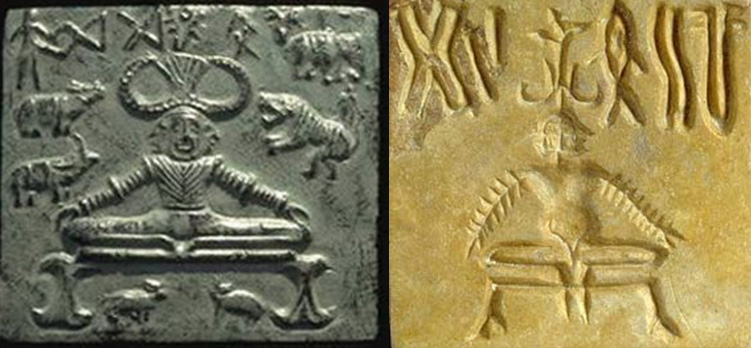

The exact origins of yoga are rather unknown. There is little documentation on exactly where and how it started. The practice was traditionally passed down orally from guru to student and any early recordings of it were done on palm leaves which would not have preserved well. Early yoga teachings were also kept very secretive and only much later did it become shared and available to the general population.
The earliest evidence of the existence of yoga dates back to the Indus Valley Civilizations, roughly between 3000 BC and 2000 BC. It is in this area where excavations have revealed imagery on stone tablets depicting figures in yogic poses.

The earliest Sanskrit texts that make any reference to yoga date back to around 1500 BC and they are known as the Vedas. These scriptures contain the oldest written text of the Indian religious tradition and consist of four separate sections: Rigveda, Yajurveda, Samaveda and Atharavaveda. They were composed by sages and are a collection of mantras, hymns and rituals. Towards the end of the Vedic period the Upanishads were written, which is a collection of over 200 short philosophical texts. They contain information on meditation and the philosophical basis upon which yoga is built, where the focus is more on spiritual transformation and sharing ways to unite the Atman (Individual Self) with Brahman (Universal Self).
After the Vedic period emerged one of the most important sacred texts known as the Bhagavad Gita, which scholars are dating to around 500 BC / 200 BC. The text tells the story of a warrior who is going into battle and realizes the opposing army consists of family, friends and comrades. The idea of killing his loved ones and comrades saddens him resulting in him refusing to fight. The remainder of the texts lay out the conversation that the warrior has with his charioteer, which results in the broadening of yoga, as various paths are discussed that can lead to the union with the divine. The three paths of yoga discussed in the Bhagavad Gita are Karma Yoga (path of selfless service), Bhakti Yoga (path of devotion) and Jnana Yoga (path of knowledge and wisdom). There is a fourth path known as Raja Yoga (path of self-control) which is outlined in the Yoga Sutras.
The Yoga Sutras is a collection of 196 aphorisms written by Patanjali around 200 CE. This text became the first standardized approach to yoga philosophy, trying to take all the various ideas of yoga and present them in a meaningful way. It is focused on Raja yoga practices and is the text most studied by Hatha yoga practitioners today. The Yoga Sutras lays down the pathway to take to reach spiritual liberation and these steps are known as the 8 Limbs of Yoga.
A few centuries after The Yoga Sutras, yoga transformed into a system where the physical body became more important and it was no longer just about the mind. The idea that the physical was connected to the non-physical aspects of life emerged and more focus was placed on the physical realms of life. Practitioners introduced various techniques to cleanse the body and mind to channel the energy of the universe within ourselves and dissolve any physical blockages that keep us attached to the physical world. This was to increase our life span and ultimately reach transcendence. With this system and belief that the human body is a temple we see yoga evolve into what we know it as today, Hatha Yoga.
Hatha Yoga refers to all forms of physical yoga that focus on realigning our energies with poses, breathing and meditation. The Hatha Yoga Pradipika is the earliest Sanskrit text written that resembles what modern yoga has become. It was written by Rishi Swatmarama in the 1400s and describes cleansing practices, poses, breathing exercises and also discusses energetic concepts like chakras.
Yoga began to make its way to the west in the late 1800’s and early 1900’s when various teachers such as Swami Vivekananda, Tirumalai Krishnamacharya, Swami Sivananda, Pattabhi Jois, B.K.S Iyengar and others started travelling to the West sharing their practices and growing a following. Hatha Yoga has taken on various styles over the years and evolved into various forms of Hatha Yoga such as Ashtanga Yoga, Vinyasa Yoga, Yin Yoga, Kundalini Yoga, Iyengar Yoga and Hot Yoga. Only the future knows what it will continue to evolve into.